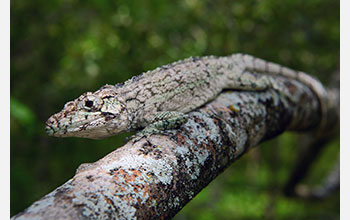Multimedia Gallery
Newly discovered lizard species Anolis landestoyi
The newly discovered species Anolis landestoyi from the island of Hispaniolan.
More about this image
The Anolis lizards of the Greater Antilles islands are well known to the biological science community as textbook examples of replicated adaptive radiation, a phenomenon where related species evolving on different islands diversify into strikingly similar sets of species that occupy the same ecological niches (e.g., long-tailed grass dwellers, bright green canopy lizards and stocky brown lizards that perch low on tree trunks surveying the ground for passing insects).
There are six Anolis specialist types. The fact that the same forms evolved independently on different islands suggests that the evolution of island communities can be deterministic; however, not all Greater Antillean anoles have a matching counterpart on another island (roughly one-fifth of the region’s anole species stand out as exceptions to the rule).
The most noticeable of these unique lizards are Cuban anoles from the Chamaeleolis group. These large, cryptic and slow-moving lizards cling to lichen-covered branches high in the canopy and look more like chameleons than typical anoles.
It was thought that there was nothing like these Cuban lizards on the other Greater Antillean islands, but a published report by a team of researchers, led by Luke Mahler of the University of Toronto, discusses the unexpected discovery of a large, distinctive Anolis lizard from the Caribbean island Hispaniola.
Named Anolis landestoyi after Dominican naturalist Miguel Landestoy, who first observed the species and recognized it as new, the lizard is not like any other anole from its own island but is strikingly similar to Chamaeleolis anoles from Cuba. Although found on different islands, both are large, reclusive, chameleon-like lizards that blend perfectly with the canopy branches on which they perch.
The discovery of A. landestoyi clarifies the view of replicated adaptive radiation in anoles, adding new support for the idea that the assembly of island faunas can be substantially deterministic. It also shows that researchers can continue to learn new things about already well-studied groups. (Date image taken: Unknown; date originally posted to NSF Multimedia Gallery: Feb. 16, 2017)
Credit: Photo courtesy Miguel Landestoy
See other images like this on your iPhone or iPad download NSF Science Zone on the Apple App Store.
Images and other media in the National Science Foundation Multimedia Gallery are available for use in print and electronic material by NSF employees, members of the media, university staff, teachers and the general public. All media in the gallery are intended for personal, educational and nonprofit/non-commercial use only.
Images credited to the National Science Foundation, a federal agency, are in the public domain. The images were created by employees of the United States Government as part of their official duties or prepared by contractors as "works for hire" for NSF. You may freely use NSF-credited images and, at your discretion, credit NSF with a "Courtesy: National Science Foundation" notation.
Additional information about general usage can be found in Conditions.
Also Available:
Download the high-resolution JPG version of the image. (8.4 MB)
Use your mouse to right-click (Mac users may need to Ctrl-click) the link above and choose the option that will save the file or target to your computer.

 All images in this series
All images in this series